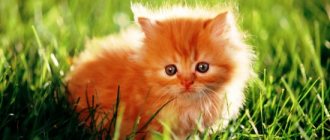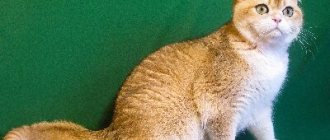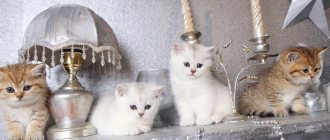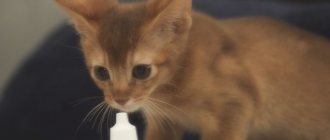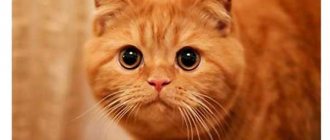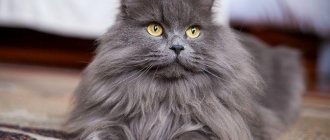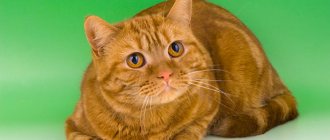Many people love cats. Many people also like ginger cats. You shouldn’t be surprised by this - this color of cat fur is pleasing to the eye and can even contribute to the owner’s good mood. Such animals can often be found just on the street, and the most beautiful ones are shown at exhibitions. Red, or rather “red” color is characteristic of many cat breeds, which will be discussed below.
Characteristic features of the “red” color
Pedigree red cats have a special beauty. Not many people know the fact that there are much fewer red cats than male cats. True, this can only be said about pure red animals. Much more often they are striped or with spots of other colors. Often the red stripes alternate with white or black. You can see this in the photo below.
Males, as a rule, have a pure red color, and these are mainly purebred animals. This phenomenon can be explained by the genetic characteristics of the cat family. At the same time, the red color is characterized by the following specific feature: it is a marbled shade and stripes. There are also breeds of red cats with a coat color that is called “coffee au lait.”
If a kitten that was recently born has red genes and so-called diluent genes from its parents, then the baby’s fur may not be brightly fiery, but acquire a pleasant creamy tint.
But be that as it may, the “red” color is considered special, since in most cases the colors of a cat’s fur come from genes with black pigment. The gene for red color can be called “individual”, possessing specific qualities.
Among the main features of cats with a red color, the following should be highlighted:
- First of all, it is worth understanding that most ginger cats are males. This is explained by the fact that pigment genes are concentrated on the sex X chromosome. And cats have only one such chromosome, which they receive from their mother. For this reason, males have a greater chance of being born with a red color. Cats have two such chromosomes. Therefore, a cat can be born red if it receives the genes for the “red” pigment from both mom and dad;
- secondly, you should know that there are practically no ginger cats that have no pattern on their fur. This can be explained by the fact that many animals have a gene called “non-agouti”. It does not allow the designs to appear in the offspring. But since red felines have the gene for their native color, the effect of “non-agouti” is neutralized in them, which leads to the appearance of patterns on the fur of kittens.
As a result, if you see a ginger cat without visible patterns on the fur in the form of stripes, spots or stains, then this is the so-called cinnamon color, which was obtained due to the influence of the black pigment gene.
The power to heal
According to legend, if a ginger cat is next to a sick person, even after surgery, that person will recover sooner. Even today, many owners of such animals can tell about the healing abilities of animals.
It is a generally accepted fact that a cat with a fiery coat color is a real charge of positivity and optimism. By creating an appropriate life-affirming mood, it literally works wonders, truly becoming an excellent medicine. It won’t be difficult for her to relieve her owner’s stress. And for those who suffer from migraine attacks and pressure changes, the benefits that fire cats can bring are priceless.
What eye color can ginger cats have?
By nature, all cats initially had green eyes. A little later, thanks to the efforts of specialist breeders, cats with blue, yellow and orange eyes were bred. In purebred animals, copper-colored eyes are much more common, although ordinary kittens also have yellow or blue eyes.
A certain eye color in small kittens can only be seen a few weeks after birth. For this reason, it is not possible to know in advance what the eyes of babies will be like. If a newborn's eyes appear brown at first, it is likely that they may later turn orange. The same applies to the initially yellow color scheme. Grayish can very possibly turn into blue.
Types of merle colors among the British
This color belongs to a group of colors called tabby (from the name of the striped fabric brought to England from Baghdad). The peculiarity of this pattern is the continuity of lines and the uniqueness of the pattern for each individual. Thanks to the efforts of felinologists, today the British marble coat is represented by many varieties.
Black marble
The main background of the coat is dark gray, the stripes have a pronounced black tint. There is a black outline around the eyes and nose, the color of the eyes is brown-orange.
British black marble shades are highly prized by animal lovers.
Black marble on silver
Charcoal stripes and spirals are symmetrically arranged on a silver background. There are dark spots near the eyes and the red-brown nose.
Black marble on silver - exquisite colors of British cats
Black marble on gold
The main color of the coat is copper-golden, the stripes have a black or dark brown tint. The eyes are most often green or yellow.
The British with the “black marble on gold” color look very presentable
Lilac marble
The silver fur coat is decorated with patterns of lavender or peach undertones. There is also a lavender rim around the nose and eyes. The iris is yellow or pale brown.
British cats with a lilac-marble hue are quite unusual
Tortoise marble
The main background can be silver-red or silver-brown, while the spots and patterns remain black or dark brown. The eyes are often yellow or greenish. The color is characteristic only of females; in rare cases it is found among males. Cats with this color cannot have offspring due to genetic characteristics.
Tortoiseshell marble involves adding reddish shades to the main color scheme
Chocolate marble
The fur coat is the color of milk chocolate, the pattern is dark brown. The eyes and nose are outlined with thick chocolate eyeliner. The color of the iris is from yellow to golden brown.
Chocolate Marble is a common color option among the British.
Bicolor
The main color with spots is diluted with white inserts on the paws, chest and belly. Eyes can be yellow, brown or green.
Bicolor color is also found among British harlequins.
Red marble
The light red fur of the main background is decorated with spots and streaks of a rich red hue. The eyes are orange, brownish-golden.
Red merle is a red British breed with merle patterns on their coats.
Red marble on silver
It is distinguished by a silvery tone of the main background, the spots have a light red color. The fur around the eyes is white, the nose is pink. The eyes are yellow or golden.
Red marble on silver - a spectacular coat color for the British
Cream marble
The main background has a shade of creme brulee, and the spots tend to be peach. There are white hairs around the eyes and a pink nose. Eyes yellow or gold.
Cream marble is a very delicate shade of the fur of British cats.
Blue marble
Silver coat with smoky gray stripes and spots, dark gray lining around the nose. The eyes are not circled and have a brown-golden tint.
The British in the shade of “blue marble” look noble
Personality of cats with red coat color
It is impossible to describe the future character of red cats and cats in a few phrases. Some breeds behave very calmly, others can be unapproachable, and still others can even become “fighters.” The behavior of pets with a red color is completely unpredictable, and over time the character of the animal can change. As children, they are playful, like all little kittens. They cannot sit still, constantly looking for entertainment and “toys.” But with age, they can turn into an affectionate pet or a “defender of the territory”, not allowing “strangers” into the house. They can hiss at strangers and even lunge at them with their claws.
Please note that ginger cats quite often get along peacefully with other pets living in a house or apartment.
Next, let's look at the cat breeds in which red color is most common.
The red cat came to the omen's house
Considering everything that was said earlier, a red cat coming to the house can be considered a very good omen, because red hair in a person’s home will bring only good events.
Such a powerful aura of a red cat will protect everyone living in the apartment. If, when leaving the house, a red cat greets you, and not just greets you, but rubs at your feet, this means joyful feelings towards you on the part of your loved ones. When a ginger cat rubs against your legs, there is a popular superstition that in this way she removes all the negativity from you, all the bad emotions and, in general, all the bad things leave you.
And don’t rush to drive away the ginger cat that came to your house. Such a visit should result in at least a hearty lunch for the red-haired guest, and then wait, maybe this unexpected meeting will eventually change your whole life.
American shorthair cat
Animals of this breed often have strong bones and a muscular, large figure. They have a beautiful head with a neat, regular shape. As a rule, such pets are very friendly, have excellent health and have all the habits of ordinary cats, because the ancestors of the American Shorthair are ordinary street cats that lived in the United States of America for more than several hundred years. Nowadays, many Americans...
Norwegian redheads
These cats are characteristically distinguished from other similar breeds by the presence of peculiar tassels on the tips of their ears. In this way they are somewhat reminiscent of small lynxes. Such animals can have different fur colors, but if you find a Norwegian red pet, then you are in luck. You can breed them and make good money from it.
As for the nature of such animals, they are quite affectionate, gentle, and sometimes very playful. Pets are very attached to their owners, love small children and do not show any aggression towards them, even if children pull their tail or ears. These are true friends of a person who will never change their home.
To the exhibition with the marble Briton
Since British cats were officially recognized as a breed back in the 1980s, these purrs regularly participate in advertising shows, seminars and exhibitions. Marble Britons were no exception.
British marbled cats are regulars at exhibitions and shows
Before sending your pet to a competition, it is necessary to carry out hygiene procedures - wash the animal, clean the eyes and ears, and comb the hair thoroughly. You also need to carefully trim the tips of the claws and give the fluffy a little sedative before the trip (1-2 drops of valerian).
To participate in the exhibition you must meet a number of requirements:
- have a veterinary passport and a document about the origin of the cat;
- the animal must be completely healthy;
- Murka should not have fleas and other parasites;
- The minimum age of a cat is limited to 3 months.
The British Marble will not be allowed to compete if:
- aggressive behavior;
- deafness;
- the presence of tattoos and other interventions in appearance.
American Curl
A distinctive feature of cats of this breed are their upturned ears. There is little else that distinguishes them from the average cat. Their build and height are average. Health is usually normal. Curls have a playful, friendly nature, despite the fact that they are descendants of the only cat that was born in America in 1981.
Wild marbled cat: description and photo
This tailed native of Southeast Asia first became known in 1837. This is a small population of cats. Today there are only 10 thousand of them. The size of the wild marbled cat is slightly larger than that of its domestic counterparts. Its length, excluding the 50-centimeter tail, is about 45–53 cm, and its weight is 4–7 kg. The pattern on the coat of such an animal resembles a clouded leopard: on a yellowish background there are large black blurry marks, the inside of which is lighter than the edges.
These owners of merle color:
- Brown eyes;
- soft and thick wool;
- rounded head;
- fairly long limbs;
- wide paws;
- elongated, richly pubescent tail.
Usually these animals are in a position with an arched back (see photo). Their habitat: southeast Asia, the eastern region of the Himalayas, Sumatra, the Indonesian part of the island of Borneo. The most favorable conditions for their existence are tropical forests. They prefer to hunt at night. Their food supply consists of rodents, mainly from the squirrel family, toads, birds and insects.
Wild marbled cats mainly move through trees. Due to their small size, they have long been classified as a subfamily of small cats (felinae). However, recent studies of their DNA have shown that they are much closer to big cats (pantherinae). It is believed that these animals are the connecting link between these subfamilies. A version has also been put forward that they are closely related to the genus of lynx.
British (shorthair and longhair)
British cats can have either short or long, plush-like fur. The color can be very different, but the red “British” breeds are of particular interest to cat fans. They have a strong build, and the muzzle is distinguished by large cheeks and round eyes, the color of which most often has an orange tint.
Representatives of Persian cats were involved in the selection process of this breed. This is why “British” kittens can be born with long hair.
British cats are considered one of the oldest breeds. They can be called calm, and they look attractive and proud, like true British. The appearance of red kittens causes a lot of excitement, since animals with this color are the most popular among cat lovers of this breed.
Although the appearance of pure red offspring is rare. As a rule, smooth-haired “British” cats are born red. Most often, they have a uniform, very rich coat color and orange eyes. However, there are also babies with spots on their paws or heads, which does not make them any less attractive for exhibitions.
How the color of the Briton was formed
There are several versions of the origin of the breed - one says that the ancient Romans brought cats from the Egyptian desert in the 1st-2nd centuries. ad. According to another legend, British cats originate from the purring Chartreuse breed, taken by medieval crusaders from the shores of South Africa.
Chartreuse cats are considered possible ancestors of the British breed
The first true Britons who settled Foggy Albion had gray-blue “stuffed” fur. This is how they were depicted in religious treatises (for example, in the Lindisfarne Gospel), poems and bestiaries. Zoologists began selection, which fixed the color, only in the 19th century, at which time the first breed standard was drawn up.
Color is the color scheme and patterns on a cat's fur coat that are formed as a result of the interaction of genetic materials responsible for the production of melanin in the body. The desired shade of coat is obtained by crossing animals with dominant and recessive genes responsible for the pattern and depth of tone. So, in British dogs with blue hair, the set of genes looks like BBdd (where B is the dominant gene that forms the black color, and d is the recessive gene responsible for muted, diluted shades). Marbled cats carry the Tb gene (where T is the dominant tabby color gene, and b is a recessive gene that makes the coat brownish, not black).
Felinologists became concerned with professionally establishing breed characteristics (including color) in British cats only after the Second World War, when the question arose of preserving this variety of domestic purrs:
- 1950 - official recognition of the British Blue breed;
- 1967 - British blue cats received the champion title from the ACA association;
- 1977 - ban on mating with other breeds, including Chartreuse;
- 1980 - recognition of the breed by the CFA Association.
Don Sphynx and St. Petersburg Sphynx (Peterbald)
Sphynxes are cats that are hairless. But this fact does not prevent animals from having their own special color. Peterbalds and Donchaks have the same origin. This breed came from one mother, who was born in the 80s of the last century in Rostov-on-Don. These pets are distinguished by the fact that they love to eat very heartily and lie under the scorching rays of the sun.
As for their appearance, both breeds have wedge-shaped heads, large ears and wide cheekbones. By nature, the animals are very friendly, affectionate, and sociable, like most representatives of the cat family.
Marble color standards
In addition to the basic standards of the breed, additional requirements have been established for British merles, which must be present in the exterior. The absence of at least one sign leads to the culling of the pet and the inability to participate in further breeding.
Marble British should have a clear pattern
Interestingly, the classic letter “M” on the forehead of tabby cats is associated with the prophet Mohammed. Allegedly, when the saint picked up a marble cat, the hair on its head became colored in a specific way. Which became a sign of the Higher Powers’ love for these purrs.
So, the marbled British cat is distinguished by the following characteristics:
- brightness, symmetry and clarity of the pattern on the fur coat;
- absence of intersections and broken lines in the patterns;
- the hairs are colored in two ways (in several shades - the hairs of the main background, in one color - the hairs of the patterns);
- the color of the iris depends on the shade of the coat; it can be copper, hazel, greenish or brown;
- there are “necklaces” on the chest, and two dark curls running parallel on the cheekbones;
- the forehead is marked with a pattern in the shape of the letter “M”, on the back of the head and shoulders there is a pattern in the form of a butterfly;
- the outer side of the ear closer to the base has a white spot;
- three long stripes of distinct dark color stretch along the ridge;
- the hips are marked with circular closed patterns;
- the tip of the tail is always marked in a dark color;
- There is a bright outline around the eyes and nose.
In addition, a classic marble cat should have small, far-set ears and massive paws. At the same time, the color of the skin on the pads of the paws, as well as on the nose, depends on the color of the animal’s fur - the darker the fur, the richer the skin tone. Seals with a silver background have pink paws and noses, red ones have crimson purrs, and “dark” British cats are completely brownish.
Table: EMS codes for coat colors in cats
| Code number | Transcript (in Russian) | Transcript (in English) |
| Main color | ||
| a | blue (blue) | blue |
| b | chocolate (Havana, brown, champagne, chocolate) | chocolate (brown, chestnut) |
| c | lilac (platinum, lilac, lilac) | lilac (lavender) |
| d | red (ed) | red (flame) |
| e | creamy | cream |
| f | black tortoiseshell (sil-torti, tortoiseshell) | tortoiseshell |
| g | blue tortoiseshell (blue-cream tortoiseshell, blue cake) | blue-tortie (blue-cream) |
| h | chocolate turtle (chocolate cake) | chocolate-tortie |
| j | lilac tortoiseshell (lilac-cream tortoiseshell, lilac-torty) | lilac-tortie |
| m | caramel | caramel |
| n | black (ebony, sable, wild, seal) | black (ebony, sable, ruddy, seal) |
| o | cinnamon (sorrel, honey) | cinnamon (sorrel, honey) |
| p | faun (beige, fawn) | fawn (beige) |
| q | Tortoiseshell cinnamon (cinnamon cake) | cinnamon-tortie (sorrel-tortie) |
| r | tortoiseshell fawn (fawn-tortie) | fawn-tortie |
| s | silver | silver |
| t | amber (amber) | amber |
| w | white | white |
| y | gold | golden |
| x | unregistered color | unregested |
| Degree of white spotting | ||
| 01 | van | van |
| 02 | harlequin | harlequin |
| 03 | bicolor | bicolour |
| 04 | bicolor for color points | mitted\white point |
| 05 | snowshoe | snowshoe |
| 09 | small white spots | little white spots |
| Tipping degree | ||
| 11 | shaded (shaded, shedded) | shaded |
| 12 | chinchilla (veil, veiled, tipped, shell) | tipped (shell) |
| Type of drawing | ||
| 21 | tabby, agouti | tabby (agouti) |
| 22 | marble (marble) | blotched (marble, classic) |
| 23 | tiger (mackerel) | tiger (maskerel) |
| 24 | spotted (rosette) | spotted |
| 25 | ticked | ticked |
| Acromelanic colors | ||
| 31 | Burmese (sepia) | burmese (sepia) |
| 32 | Tonkinese (mink, mink) | tonkinese (mink) |
| 33 | Siamese (Himalayan) | siam (himalayan) |
| 34 | Singaporean | Singapore |
| Tail length | ||
| 51 | rampy | rumpy |
| 52 | ramp riser | rumpy riser |
| 53 | stumpy | stumpy |
| 54 | longs | longy |
| Eye color | ||
| 61 | blue | blue |
| 62 | yellow | yellow, golden |
| 63 | disagreement | oddeyed |
| 64 | green | green |
| 65 | Burmese color | burmese color |
| 66 | tonkinese color | tonkinese color |
| 67 | siamese color | siam (himalayan) color |
| Ear shape | ||
| 71 | straight | straight |
| 72 | curl | curled |
| 73 | fold | fold |
| Coat type | ||
| 81 | long wool | longhair |
| 82 | short hair | shorthair |
| 83 | brush | brush |
| 84 | straight | stright |
Cornish Rex
The Cornish Rex is particularly graceful. Such cats are very active, playful, and their skin is covered with the most delicate, pleasant to the touch fur, which has the shape of rolling waves. A feature of animals of this breed should also be called “curls”. The color can be any, including a reddish tint. It is also worth noting that Cornish Rexes are descendants of one of the cats, which was born in the 50th year of the last century in the county of Cornwall in England.
Kurilian Bobtail
Kurbols have a collected body with strong bones and well-developed muscles. Representatives of this breed have a very pleasant silky coat. The main distinguishing characteristic of these cute cats is their tail, which is somewhat short for cats. Its length reaches a maximum of 8 centimeters, while it has a curved shape. The color may be red or another color. Often red stripes alternate with black ones. And the animals were called Kuril because they are descendants of their short-tailed relatives who live on the Kuril Islands.
Various signs
Many superstitions about outdoor fire cats:
- If you get a ginger kitten or you are given an animal as a gift - this is always a favorable omen for profit.
- When a cat crosses the path of a man from left to right, this is a sign of an imminent meeting with love. And from right to left - expect flirting.
- Meeting a cat on the way for a woman also means a romantic acquaintance with a man for pleasant leisure time.
- If you see how street cats got into a fight, where the saffron milk cap won, expect quick luck, good luck in any business.
- The cat came to the house and sat by the door - for the person who saw him, this meant receiving a pleasant gift, a surprise.
- When several fiery cats meet on a person’s path, you can exhale: the “dark streak” in your life is over. Get ready for the best happy changes.
You found a red kitten on the street - wealth has come into your hands. Good luck awaits the owner of the baby.
Maine Coon
Maine Coons were bred quite recently, but their temperament is quite wild. Although they are generally friendly, like most cats, they do show aggression quite often. They are quite large in size, and their weight can reach 16 kilograms. The color of the coat can be varied, including a red tint. Due to its size and weight, the Maine Coon cat is considered unique, and its appearance is simply terrifying to some, which continues to make it popular among connoisseurs of unusual pets.
Maintenance and care
Marble coloring in cats, like other shades of British cats, includes grooming. You should comb 1 rub. in 7-10 days, use a comb with medium teeth with rounded tips. A furminator is suitable because the cat has a thick undercoat. Ear and eye hygiene should be carried out at least once every 5-7 days so as not to upset the balance of natural microflora. It is recommended to brush your teeth daily with special zoopastes - “Denta-Kiss”, “Tropiclean” gel, “Sentry”, “Beafar”, “Trixie”. The cat must have toys and a scratching post. The British are squeamish, so the tray should be changed immediately, and the filler should be wood or bentonite.
Persians
Such cats are very popular among animal lovers; they are often kept in city apartments, since these cats are very cute to look at, and their character attracts with its cheerfulness and playfulness. Their fur can be called “fox”, and their eyes always look faithfully at their owner! Persians are indeed very domestic, and allow representatives of other animals, such as dogs and parrots, to live with them in the same territory.
Distinctive features of the Persian appearance are a muscular body and a snub nose. Cats have a soft, smooth coat. The fur is quite long. As for color, it can be anything, including red.
Caring for the British Marbled's fur coat
The breed is one of the cleanest and neatest cats, so the animal often takes care of its appearance on its own. At the same time, it is recommended to wash the cat every six months and comb its elegant fur at least once a week.
British marble cats do not require special care
Since the coat of British cats is quite elastic and flexible, there are no special rules for caring for it. It is recommended to regularly clean the animal’s ears (with cotton swabs dipped in warm water) and the animal’s eyes (with warm and damp cotton pads) - every 7-10 days.
Video: British marbled cat
Siberian
Siberian cats are descendants of their relatives who lived in the wild steppes. Animals of this breed are distinguished by their very large size and heavy weight, which can reach almost 15 kilograms. Thanks to their ancestors, these pets have a special interest in hunting, and they always drag their prey into the house to show off to the owner.
Although Siberians are distinguished by their warlike, wild disposition, this does not prevent them from being very affectionate and devoted to their owners. Since these cats are very large and always go out hunting, it is not recommended to keep them in city apartments. For such “hunters”, private houses or dachas outside the city limits are more suitable.
Habits of the Siberian cat and its character
Since Russian Siberian cats are closely related to their steppe ancestors, they delineate the border of their possessions and protect it from the encroachments of other cats. They are well versed in the area and, if they go far from home, they are always able to find the way to their place of residence.
The breed is not aggressive. But on fundamental issues, animals enter into battle with courage and bravery, without retreating from the enemy. Sometimes cats get seriously injured because of this.
This is interesting: this breed still improves its blood at the expense of wild cats. The Siberian cat sometimes gives birth to offspring from wild animals. As a result, strong, large kittens are born, “Siberians” in the full sense of the word.
Natural predators and hunters resemble dogs in their habits. They hunt for small animals and often bring home a “trophy” to show their owners that they are serving faithfully. We are talking about animals living in rural conditions that can walk “in the open air.”
The Siberian cat loves to be close to its owners, but its behavior is unobtrusive. He happily goes to sleep at the feet or on the owner’s personal belongings. He is distinguished by his flexible character: you can always “agree” with him. But until old age he remains a hunter and player, so he will not refuse to play with a person or go hunting.
Siberian cats never throw themselves underfoot, do not strive for communication, but love to watch their owners
It is important for them that the events taking place take place under their supervision. They usually choose a place in the room where they have a full view
Note: The Siberian cat does not like to be stroked or touched without her desire. But she allows herself to be tormented and squeezed by children, without hurting or scratching the baby. Sometimes it is noticeable that the cat is looking after the child and his behavior.
Scottish (low-eared and straight-eared)
This breed of cat has one characteristic feature - a special shape of the ears. They are pressed close to the head, very small and have a round shape. The Scots are small in size, their coat is quite dense and can be either long or short. The fur of such pets can have different colors. Red and white-red cats are very rare.
As for their character, the “Scots” are somewhat reminiscent of dogs. This is confirmed by the fact that animals become strongly attached to their owners and are incredibly loyal. And having chosen “their” owner, such cats stop paying attention to other family members.
British among cats
This breed is popular due to its independent and patient disposition, because British women will never get bored in the absence of their owner. At the same time, plush purrs are not devoid of a sense of tact and show full love to those who take care of them and treat them with tasty treats.
British cats are the embodiment of calm and intelligence
The British are distinguished by high intelligence - by changing the “notes” in the breadwinner’s voice, the cat will understand that it is doing something wrong. However, these little cats cannot be called too mischievous or vindictive - calmness is their strong point. At the same time, British cats are not inclined to become toys in children's hands; with excessive attention from children, the cat will prefer to run away.
Externally, British catfish differ in the following parameters:
- thick coat with dense undercoat;
- round, close-set eyes of amber color;
- massive head on a short neck;
- wide cheekbones;
- small nose with a wide bridge;
- ears widened at the base with rounded tips;
- muscular body on wide, strong legs;
- medium-length tail, rounded at the end.
Turkish Angora
Turkish Angora cats have a very interesting physique. They are distinguished by their special grace, soft long fur, and their heads are wedge-shaped like those of sphinxes. The size of such pets is quite large, and the color is most often white. Although red angoras are not an exception at all.
So, we have described the most popular cat breeds for which the red color is natural, although not obligatory. It is worth noting that with the same shade you can find other breeds of these cute animals, for example, Selkirk, Oriental, Canadian Sphynx, La Perm, Devon Rex and others. According to some legends, red cats are able to protect their owners from the negative influence of evil people, and bring prosperity to the house.
